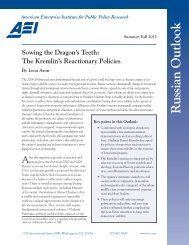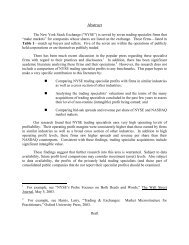Download the PDF - American Enterprise Institute
Download the PDF - American Enterprise Institute
Download the PDF - American Enterprise Institute
You also want an ePaper? Increase the reach of your titles
YUMPU automatically turns print PDFs into web optimized ePapers that Google loves.
10 SLAVERY AND THE CONSTITUTIONAL CONVENTION<br />
which includes <strong>the</strong> present states of Ohio, Indiana, Illinois, Michigan,<br />
and Wisconsin. That’s quite a large swath of land.<br />
All of <strong>the</strong>se developments produced an increase in <strong>the</strong> number of<br />
free blacks in both North and South. In 1790, it’s estimated that<br />
about 8 percent of all blacks in <strong>the</strong> United States were free. By 1810,<br />
14 percent were free. The number of slaves was conversely affected,<br />
with <strong>the</strong> number of slaves dropping in those years.<br />
These few facts should make clear that <strong>the</strong> world <strong>the</strong> men at <strong>the</strong><br />
Convention faced in 1787 was not <strong>the</strong> world <strong>the</strong> nation faced in <strong>the</strong><br />
1850s. These facts should make clear that <strong>the</strong> trajectory of slavery<br />
in 1787 was not <strong>the</strong> trajectory that led to <strong>the</strong> entrenching of slavery<br />
in <strong>the</strong> 19th century. To understand slavery at <strong>the</strong> Constitutional<br />
Convention, we must look at it as <strong>the</strong>y did with <strong>the</strong>ir eyes, and not<br />
with our eyes, ei<strong>the</strong>r enriched or clouded by our knowledge of subsequent<br />
history.<br />
As I said, <strong>the</strong> two main ways of looking at this topic are <strong>the</strong> Neo-<br />
Lincolnian and <strong>the</strong> Neo-Garrisonian. I’m going to propose a third—<br />
<strong>the</strong> Neo-Madisonian approach, which is named for James Madison,<br />
who I think was <strong>the</strong> person at <strong>the</strong> time of <strong>the</strong> Founding who understood<br />
<strong>the</strong> Constitution best. I see <strong>the</strong> Neo-Madisonian position as a<br />
kind of middle ground between <strong>the</strong> Neo-Lincolnians and <strong>the</strong> Neo-<br />
Garrisonians, although not <strong>the</strong> kind of middle ground that just<br />
splits <strong>the</strong> difference between <strong>the</strong>m.<br />
One of <strong>the</strong> ways in which it’s a kind of middle ground is that <strong>the</strong><br />
Neo-Madisonian view holds <strong>the</strong> Constitution to be nei<strong>the</strong>r proslavery<br />
as <strong>the</strong> Neo-Garrisonians say, nor quite antislavery in <strong>the</strong> way <strong>the</strong><br />
Neo-Lincolnians say. The Neo-Madisonian position denies that <strong>the</strong><br />
Constitution endorses <strong>the</strong> institution of slavery as legitimate and<br />
right. But it also denies that <strong>the</strong> Constitution made provisions to<br />
stamp out slavery—or, as Lincoln put it, that it consigned <strong>the</strong> institution<br />
to “ultimate extinction.” Ra<strong>the</strong>r, <strong>the</strong> Neo-Madisonian position<br />
says a few things more subtle than <strong>the</strong>se—three things in particular.<br />
First, it affirms that slavery is legal but not legitimate; second, it<br />
postpones or defers any disposition of <strong>the</strong> issue of slavery; and<br />
third, it does so for reasons deep in <strong>the</strong> fundamental principles of<br />
<strong>the</strong> Constitution, so deep as to make it nearly inevitable that slavery






